Poison
Author: Reiner Knizia
Publisher: Playroom Entertainment
Year: 2005
review by

| x |
|
|
|
|
|
|
|
|
|
|
|
|
|
|
|
|
|
|
|
|
|
|
|
|
|
|
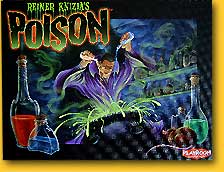 |
With more than 200 games, Reiner Knizia is by far the most productive among the game authors. These games include classics like Tigris and Euphrates, Taj Mahal, and Amun Re, but also numerous fillers, and even complete misses. Therefore, a ‘Knizia’ is not a guarantee for quality, and precaution should be taken with a new game from his hand. The game ‘Poison’, published in the United States falls in the category of quick fillers, a category that has been well supplied by the various publishers. It remains to be seen if ‘Poison’ will be a welcome addition.
|
| x |
|
|
|
|
|
|
|
|
|
|
|
|
|
|
|
|
|
|
|
|
|
|
|
|
|
|
| What really strikes at first sight is the size of the box. You wouldn’t really expect a card game from a box this large. After opening it becomes apparent that the box is required to hold three over-sized illustrations of cauldrons, printed on sturdy cardboard. Calling this over-the-top would be an understatement. A set of cards, rules printed on glossy paper, and (it’s the detail that counts) a small rubber band are also included in the box. |
|
  |
| x |
|
|
|
|
|
|
|
|
|
|
|
|
|
|
|
|
|
|
|
|
|
|
|
|
|
|
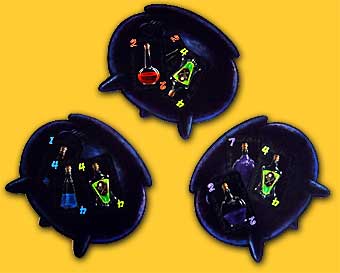 |
The cards in ‘Poison’ represent potions in three different flavours (colours): red, blue, and purple. Then there are the green ‘glow-in-the-dark’ poison cards, which are meant to spoil the other potions. The normal cards are numbered 1, 2, 4, and 7, while all the poison cards have the number 4. All fifty cards are shuffled and dealt to the players, and on a turn a player chooses a card from his hand and places it ‘in’ one of the three cauldrons. Each cauldron can contain exactly one kind of potion, possibly poisoned by the poison cards, which can be placed into any cauldron. Whenever a player adds a card to a cauldron, and cards sum up to more than 13, than this player must take all cards in that cauldron, without the card just played. |
| x |
|
|
|
|
|
|
|
|
|
|
|
|
|
|
|
|
|
|
|
|
|
|
|
|
|
|
All cards taken from a cauldron are placed in front of the player (upside down). At the end of the round, after all players have played all their cards, each player counts his cards (if any). Each potion card is worth 1 (penalty) point, a poison card 2 points. The goal is to obtain the lowest score. A nice twist is that whenever a player has obtained the most in one of three normal potion cards, the player can discard these cards completely. It may therefore be attractive to force a cauldron to ‘overcook’, and obtain the majority in a certain colour, but any added poison makes this off course less attractive. A ‘venomous’ action is to try to set all cauldrons to 13, thereby forcing your left neighbour to take the cards of a cauldron.
|
|
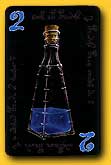 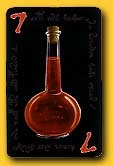 |
 |
|
|
|
|
|
|
|
|
|
|
|
|
|
|
|
|
|
|
|
|
|
|
You never have enough filler games around the house, especially when you yourself organize the gaming sessions. Whenever there is too less time for a ‘real’, that is: longer game, but too much time to call it a day or night, this kind of short card game is really suitable. Just 20 minutes of teasing and fooling around, maybe settling the scores of previously played games, and then off. The design is typical American, with overproduced, superfluous cauldrons, but then again, especially for the first time this makes a nice, exclusive presentation. In addition, the real Knizia-fan will recognize his idol in the mad professor on the front of the box. Hopefully, this pose is not telling, and will ‘Herr Doktor’ soon surprise us all with the new classic the real gamer expects from him.
© 2006 Edwin van de Sluis
Poison, Reiner Knizia, Playroom Entertainment, 2005 - 3 to 6 players, 8 years and up, 30 minutes
Postscript Richard: Reiner Knizia is like a Japanese fishing trawler: with large dragging trawls he indiscriminately hunts the games pool from which no idea, whatever size, can escape. This side capture however should have been returned as undersized...
|
|
 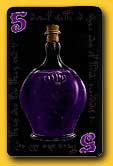
 |
  |
|
|
|
|
|
|
|
|
|
|
|
|
  |
|
|
|
|
|
|
|
|
|
|
|
|
  |
|
|
|
|
|
|
|
|
|
|
|
|
| x |
|
|
|
|
|
|
|
|
|
|
|
|
|
|
|
|
| x |
|
|
|
|
|
|
|
|
|
|
|
|
|
|
|
|
 |
|
|
|
|
|
|
|
|
|
|
|
|
 |
|
|
|
|
|
|
|
|
|
|
|
|
| x |
|
|
|
|
|
|
|
|
|
|
|
|
|
|
|
|
 |
|
|
|
|
|
|
 |
|
|
|
|
|
|
|
|
|
|
|
|
|
|
|
|
|
|
|
|
|
|
|
|
|
|
|
|
|
|
|
|
|
|
|
|
|
|
|
|
|
|
|
|
|
|
|
|
|
|
|
|
|
|
|
|
|
|
|
|
|
|
|
|
|
|
|
|
|
|
|
|
|
|
|
|